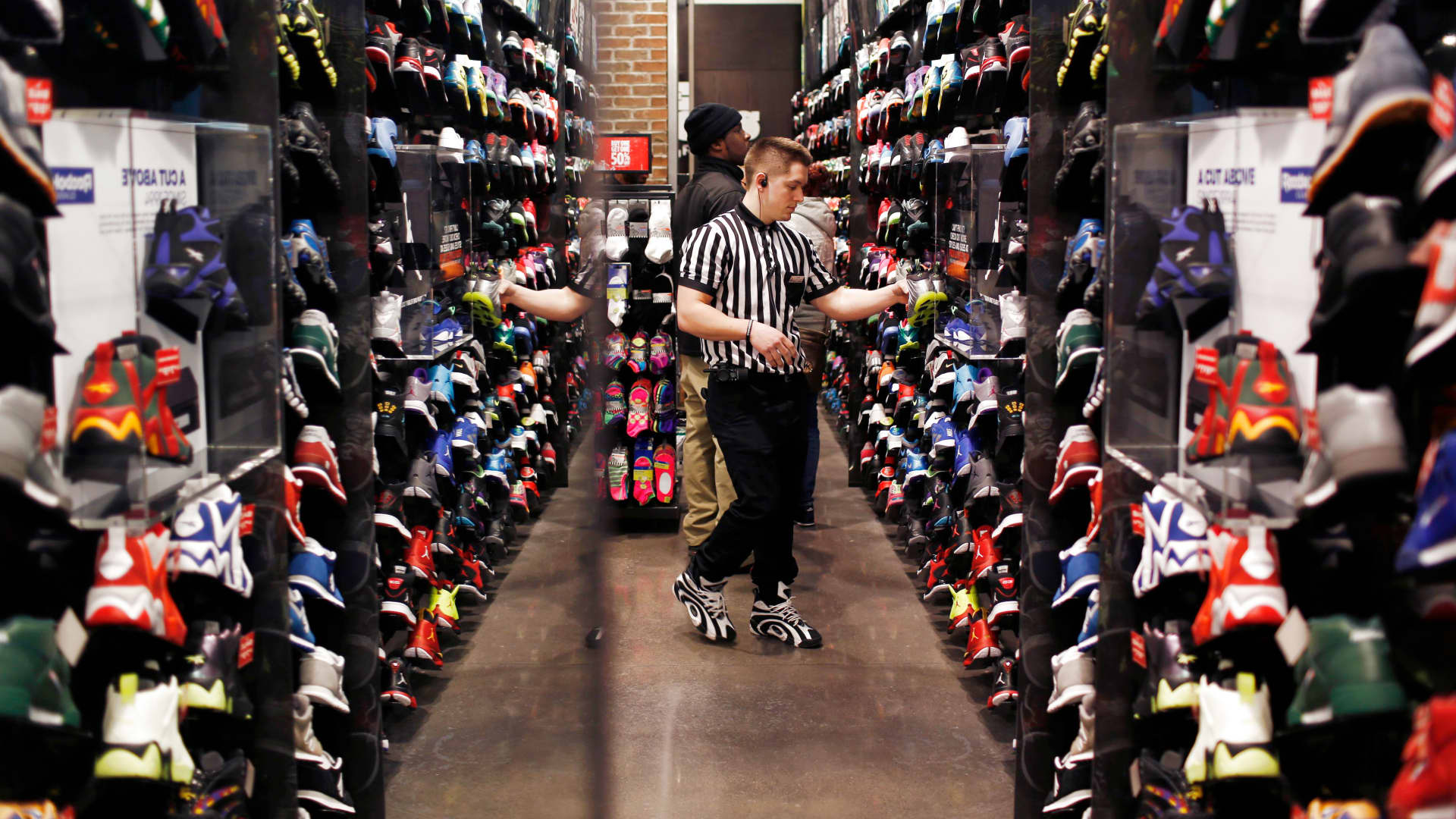We’re revising price targets on 5 Club stocks, adding a U.S. retailer to the bullpen and sticking with a key bank


The Club on Friday is updating five price targets for stocks in the portfolio to reflect recent developments at the companies and broader macroeconomic trends. We’re also adding a new stock to the bullpen, while reiterating our support for Morgan Stanley amid the recent upheaval in the banking sector. Meta We’re increasing our price target on Meta Platforms (META) to $220 per share, from $195. This new target represents about 18-times 2024 earnings estimates. Over the last two months, analysts have steadily increased their earnings estimates on Meta, and the stock has appreciated alongside those revisions to above our previous target. Since Jan. 31, the day before Meta announced fourth-quarter results , the consensus earnings-per-share (EPS) estimate for 2023 has moved up about 24%, to $10, from $8.08 per share. For 2024, the consensus EPS estimate has risen 2%, to $12.39, from $10.14 a share. The driving forces behind those analyst revisions are the company’s emphasis on improving efficiency through a second round of layoffs , controlling its costs by reducing its 2023 expenses outlook and, most recently, signs of so-called green shoots at its advertising business for its family of applications. That’s a result of the continued monetization of its Reels short-form video offering on Facebook and Instagram, along with the easing of ad-targeting headwinds. The two fundamental ingredients that drive higher stock prices are earnings and the valuation multiple investors are willing to pay for those earnings. Generally, higher earnings are our preference of the two. Sometimes multiple expansion is just a great fool theory. In essence, you are buying a stock because you think someone else will pay more for it in the future. But when earnings are up, it’s because the value of the company is increasing. With estimates pushing higher, we think the rally in META still has more room to run, prompting us to raise our price target. Nvidia We’re increasing our price target on Nvidia (NVDA) to $300 per share, from $240. This new target puts Nvidia’s valuation at a pricey 67-times the consensus EPS estimate for next year. But the chipmaker is uniquely worthy of such a premium because it is the unrivaled leader in accelerated computing and artificial intelligence (AI), which is finally at an inflection point after having what CEO Jensen Huang called its “iPhone moment.” Nvidia has previously said generative AI — which includes applications like OpenAI’s ChatGPT — has a total addressable market of $600 billion split between hardware and software. Indeed, with the channel inventory correction in gaming largely behind Nvidia and new orders for its H100 graphics processing unit (GPU) accelerating to support generative AI, it’s likely that earnings estimates this year are too low. Energy We’re reducing our price targets on Coterra Energy (CTRA), Devon Energy (DVN), and Pioneer Natural Resources (PXD) to reflect the lower prices of both oil and natural gas. For all three names, we are lowering our price targets to the consensus price, according to FactSet. That means reducing Devon Energy to $68 per share from $82, Coterra Energy to $30 per share from $40, and Pioneer to $259 per share from $300. We’re also downgrading Devon to a 3 rating , meaning we’ll look to sell shares into strength — part of a broader move to consolidate our energy holdings and free up space in the portfolio. Our rationale behind keeping Pioneer is its higher dividend yield of 11.8%, compared with Devon’s 7.6% yield. With Coterra, we support its shift to focus on share repurchases over paying out a variable dividend. Favoring buybacks over dividends make more sense to us, with the stock down more than 30% from last year’s high. Bullpen The newest addition to our bullpen is Foot Locker (FL). The sneakers and athletic-wear retailer plays a large role in the $80 billion sneaker market, which has been growing at a mid-single digit clip thanks to three big tailwinds, according to the company. The first is mass casualization, whereby hybrid work and new norms of wearing sneakers with dress clothes have boosted sneaker sales. The second is traditional and new performance sneaker brands becoming fashion statements. And the third tailwind is the rise of sneakers as a vehicle of individual expression. In the 2021 Piper Sandler Spring Teen Survey, 25% of teens identified as a “sneakerhead” or a sneaker enthusiast that is likely to own multiple pairs. But the rising tide of sneakers hasn’t lifted all ships. Foot Locker has struggled over the past few years because it was mostly thought of as a reseller of Nike (NKE), which has shifted gears to double down on its own direct-to-consumer business. Foot Locker has also been a victim of the shift to shopping on ecommerce platforms, given its large presence in malls. Foot Locker needed a change. And in September, the company appointed retail industry veteran Mary Dillon, the former CEO of Ulta Beauty (ULTA), as its new CEO. On Monday, Dillon unveiled Foot Locker’s new “Lace Up” strategy, in conjunction with its fourth-quarter results and Investor Day event, while stopping by “Mad Money” to talk with Jim Cramer. Dillon is hitting the reset button in 2023 in order to put the business on a path towards sustainable growth. To do this, management plans to diversify its brand mix to offer more sneaker choices to become less beholden to Nike; optimize its store footprint by exiting 400 underperforming stores; launch new store concepts; and accelerate investments in technology and its loyalty program. But all these actions will come at a price, with management expecting 2023 earnings to be down 30%. We don’t want to make light of how big this haircut to earnings will be, but as Foot Locker’s growth initiatives and cost savings programs play out, it should quickly return to growth in 2024. And in the years after that, management’s financial targets look very robust. In 2024 through 2026, management expects annual sales growth of 5% to 6%, with comparable sales growth of 3% to 4%, and earnings before interest and taxes (EBIT) margins reaching 8.5% to 9% by the end of 2026. For comparison, EBIT margins are expected to be 5.7% in 2023. After including share buybacks every year, Foot Locker sees its adjusted EPS growing by a low-to-mid-twenties percentage rate annually from 2024 to 2026. For a stock that currently trades at about 11-times earnings, this isn’t growth at a reasonable price, it’s growth at a very cheap price. Of course, a price-to-earnings multiple that low implies some skepticism around Foot Locker’s ability to make good on its goals. Turnarounds are never easy and the company continues to face headwinds from Nike and its traditional mall presence. So it’s now up to Dillon to deliver. But if she can do for Foot Locker what she achieved at Ulta Beauty, Footlocker’s shares can go much higher. And in the interim, the company’s current 4% dividend yield represents a solid payment to hold us over. Morgan Stanley We continue to see great value in the Morgan Stanley (MS) franchise but haven’t added to our position because we already own so much and can’t meaningfully improve our cost basis while the stock is in the $80s-per-share range. We would like to see it go a little lower, with a dividend yield closer to 4%, as we await a resolution to the troubles at First Republic Bank (FRC). Despite the challenges facing regional and community banks, Morgan Stanley should still emerge as a net winner from the ongoing turmoil. Along with other big banks, Morgan Stanley committed $2.5 billion of uninsured deposits to First Republic Bank, in a likely sign that MS saw inflows since the collapse of Silicon Valley Bank two weeks sparked the current uncertainty. Furthermore, Morgan Stanley’s business model is driven by wealth-and-asset-management fees and is less reliant on collecting deposits and issuing loans. (See here for a full list of the stocks in Jim Cramer’s Charitable Trust.) As a subscriber to the CNBC Investing Club with Jim Cramer, you will receive a trade alert before Jim makes a trade. Jim waits 45 minutes after sending a trade alert before buying or selling a stock in his charitable trust’s portfolio. If Jim has talked about a stock on CNBC TV, he waits 72 hours after issuing the trade alert before executing the trade. THE ABOVE INVESTING CLUB INFORMATION IS SUBJECT TO OUR TERMS AND CONDITIONS AND PRIVACY POLICY , TOGETHER WITH OUR DISCLAIMER . NO FIDUCIARY OBLIGATION OR DUTY EXISTS, OR IS CREATED, BY VIRTUE OF YOUR RECEIPT OF ANY INFORMATION PROVIDED IN CONNECTION WITH THE INVESTING CLUB. NO SPECIFIC OUTCOME OR PROFIT IS GUARANTEED.
An employee arranges a sneaker display at a Foot Locker Inc. store inside the South Park Mall in Strongsville, Ohio.
Luke Sharrett | Bloomberg | Getty Images
The Club on Friday is updating five price targets for stocks in the portfolio to reflect recent developments at the companies and broader macroeconomic trends. We’re also adding a new stock to the bullpen, while reiterating our support for Morgan Stanley amid the recent upheaval in the banking sector.
